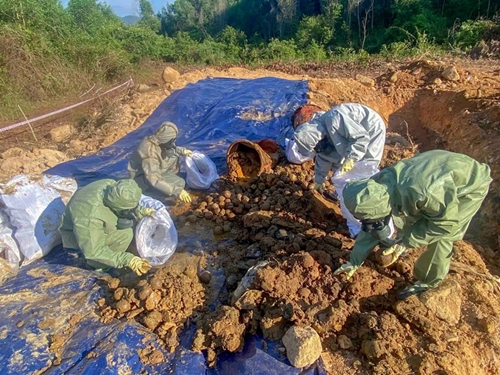Troops in tight uniforms and with special equipment coordinated with their peers from the Institute of Military Environmental Chemistry under the Chemical Corps to implement the task. Their efforts have actively contributed to protecting the environment and reviving dead lands.
Near noon, the sun became hotter, but in the field, the troops were still actively digging and collecting CS and weapons containing CS for destruction.
    |
 |
|
Troops of Chemical Battalion 78 collect and process toxic chemicals. |
At the end of the shift, taking off their protective suits, all troops were drenched in sweat. Commanding the troops and directly engaging in the work, Major Ho Minh Nam, head of Reconnaissance Company 1, Chemical Battalion 78, said that performing difficult and dangerous tasks in harsh weather conditions greatly affected troops’ health. Therefore, depending on specific situations, the unit defined working hours for troops and regularly supplemented nutrition and rations to improve troops’ health condition.
After more than half a month of performing the mission, at the end of Phase 1, the forces collected nearly 140 tons of CS and CS-hydrolyzed products. The collected will be destroyed using the latest treatment technology in Phase 2 that will last about 3 months at the National Military Training Center 2.
According to statistics from the Stockholm International Peace Research Institute (Sweden), during the war in Vietnam, in the 1961-1971 period, the U.S. imperialists spread 9,000 tons of CS over the Central and Southern regions. Large quantities of CS and weapons and vehicles containing CS were stored in depots and military bases of the U.S. and Saigon Army across battlefields, including bases in Military Region 5. In 2004 and 2005, Military Region 5 and other units joined hands in treating CS and CS-containing weapons in burial pits at the foot of Cu Mong pass (present Area 8, Bui Thi Xuan ward, Quy Nhon city). To thoroughly handle toxic chemicals left over from the war, functional forces have coordinated to collect and treat them with new technology.
Senior Colonel Pham Phu Dung, Head of the Chemical Department of Military Region 5, said that although working in harsh weather conditions, wearing protective suits for many hours, officers and soldiers of Military Region 5’s Chemical Department always exerted great efforts, overcame difficulties, and successfully completed their assigned tasks.
The war has passed for nearly half a century, but its consequences are still severe for both people and ecological environment. Silently facing the danger of toxic chemicals, chemical troops of Military Region 5 are making efforts to realize the policies of the Party, State and Ministry of National Defense in reviving dead lands, bringing back a clean environment so that local people could feel secure in production and socio-economic development and enjoying a prosperous and happy life.
Translated by Mai Huong